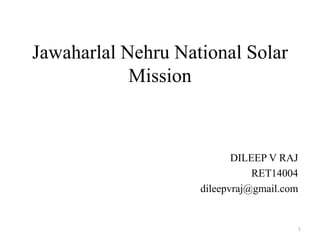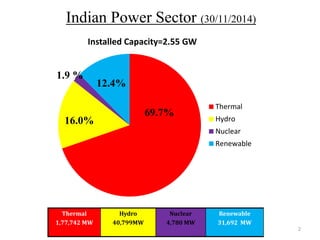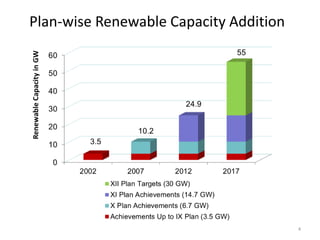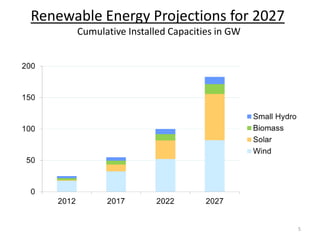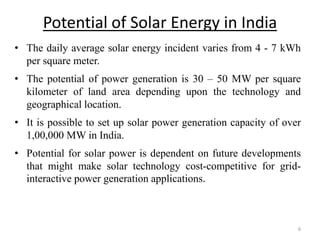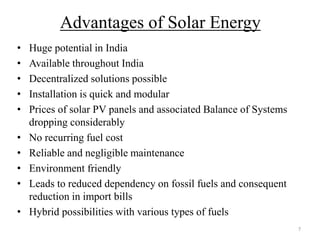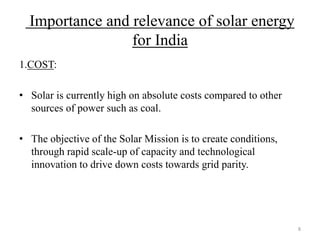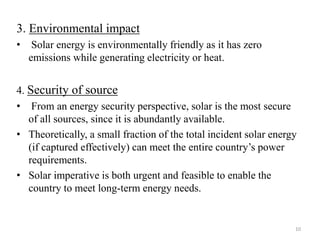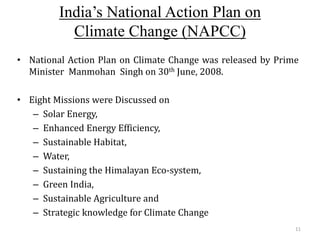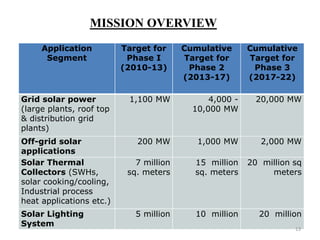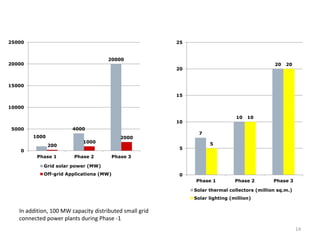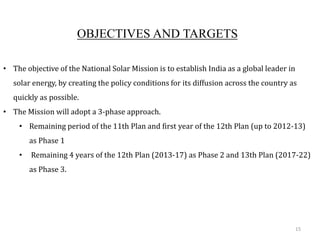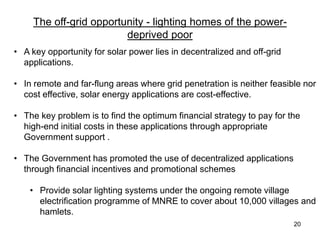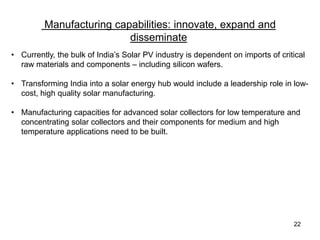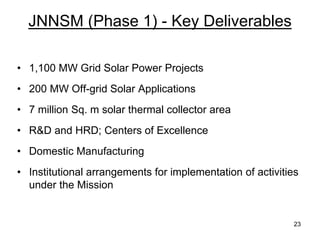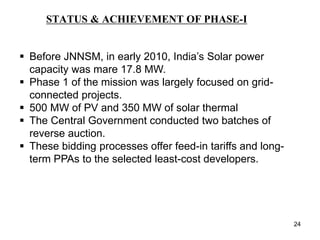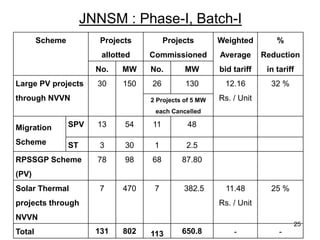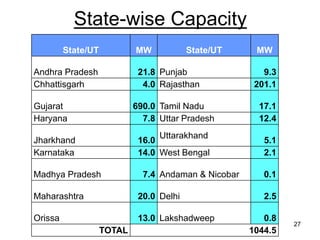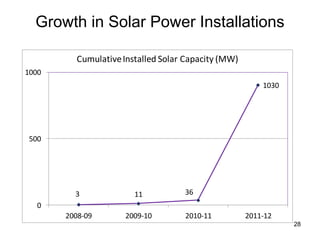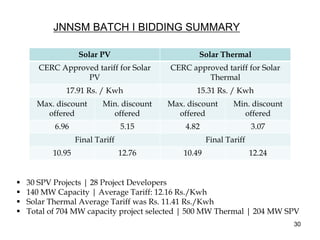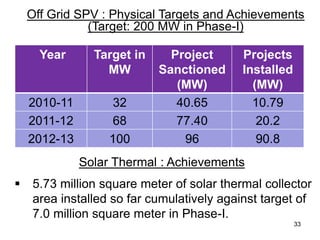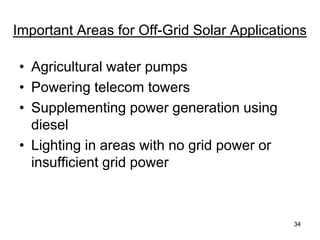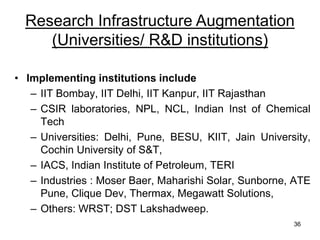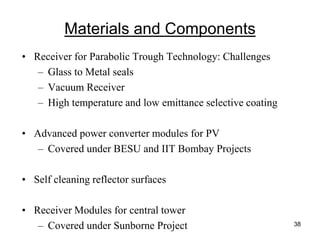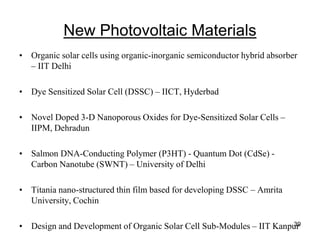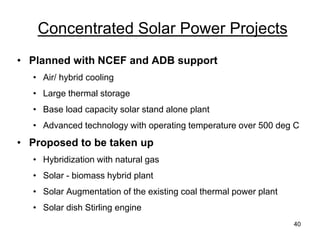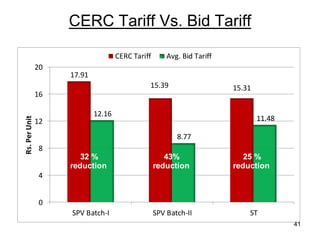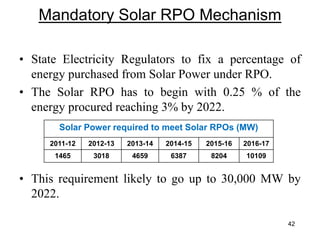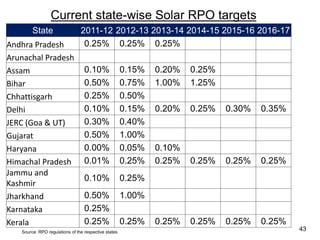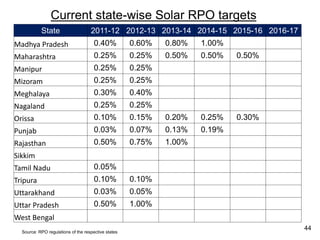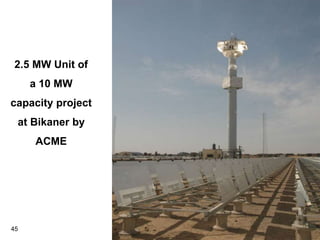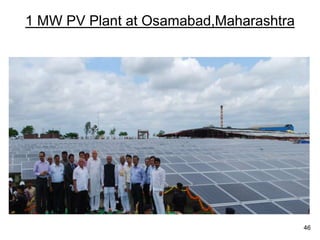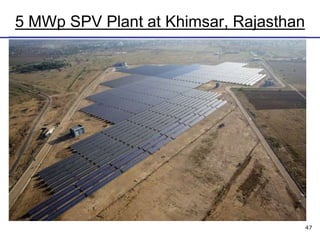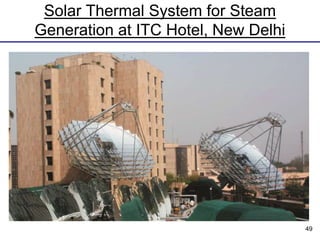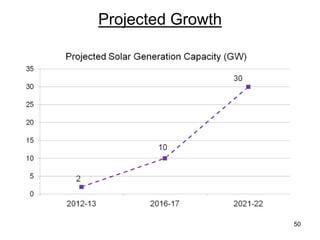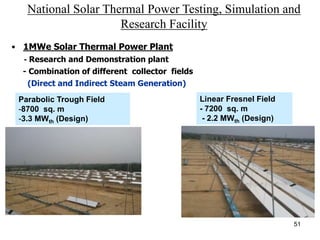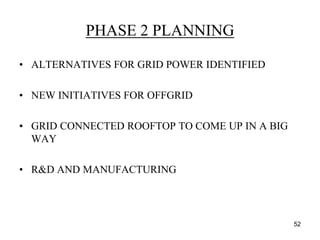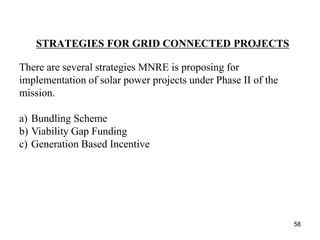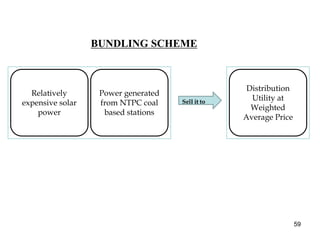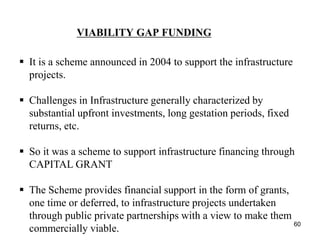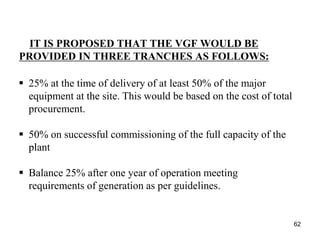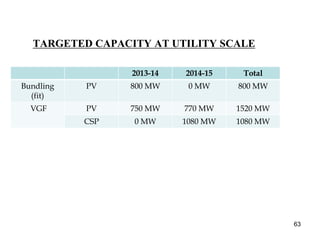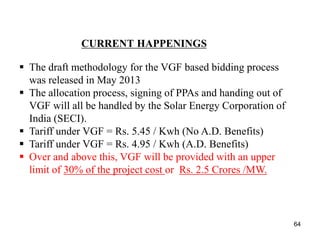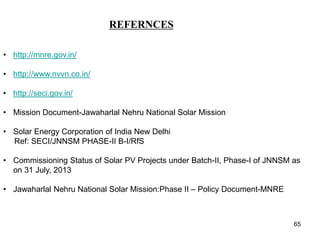Jawaharlal nehru national solar mission
- 1. Jawaharlal Nehru National Solar Mission DILEEP V RAJ RET14004 dileepvraj@gmail.com 1
- 2. Installed Capacity=2.55 GW Thermal Hydro Nuclear Renewable 69.7% 12.4% 1.9 % 16.0% Thermal 1,77,742 MW Hydro 40,799MW Nuclear 4,780 MW Renewable 31,692 MW Indian Power Sector (30/11/2014) 2
- 3. Small Hydro Bio Solar 72.74% 9.91% 4.42% 12.92% Wind 22465.03 MW Small Hydro 3990.83 MW Bio 1365.2 MW Solar 3062.68 MW Total 30883.74 MW Renewable Power Capacity (31/12/2014) 3
- 4. Plan-wise Renewable Capacity Addition 4
- 5. Renewable Energy Projections for 2027 Cumulative Installed Capacities in GW 5
- 6. Potential of Solar Energy in India • The daily average solar energy incident varies from 4 - 7 kWh per square meter. • The potential of power generation is 30 – 50 MW per square kilometer of land area depending upon the technology and geographical location. • It is possible to set up solar power generation capacity of over 1,00,000 MW in India. • Potential for solar power is dependent on future developments that might make solar technology cost-competitive for grid- interactive power generation applications. 6
- 7. Advantages of Solar Energy • Huge potential in India • Available throughout India • Decentralized solutions possible • Installation is quick and modular • Prices of solar PV panels and associated Balance of Systems dropping considerably • No recurring fuel cost • Reliable and negligible maintenance • Environment friendly • Leads to reduced dependency on fossil fuels and consequent reduction in import bills • Hybrid possibilities with various types of fuels 7
- 8. Importance and relevance of solar energy for India 1.COST: • Solar is currently high on absolute costs compared to other sources of power such as coal. • The objective of the Solar Mission is to create conditions, through rapid scale-up of capacity and technological innovation to drive down costs towards grid parity. 8
- 9. 2. SCALABILITY • India is endowed with vast solar energy potential. • About 5,000 trillion kWh per year energy is incident over India’s land area with most parts receiving 4-7 kWh per sq. m per day • Solar thermal and solar photovoltaics, can effectively be harnessed providing huge scalability for solar in India. 9
- 10. 3. Environmental impact • Solar energy is environmentally friendly as it has zero emissions while generating electricity or heat. 4. Security of source • From an energy security perspective, solar is the most secure of all sources, since it is abundantly available. • Theoretically, a small fraction of the total incident solar energy (if captured effectively) can meet the entire country’s power requirements. • Solar imperative is both urgent and feasible to enable the country to meet long-term energy needs. 10
- 11. India’s National Action Plan on Climate Change (NAPCC) • National Action Plan on Climate Change was released by Prime Minister Manmohan Singh on 30th June, 2008. • Eight Missions were Discussed on – Solar Energy, – Enhanced Energy Efficiency, – Sustainable Habitat, – Water, – Sustaining the Himalayan Eco-system, – Green India, – Sustainable Agriculture and – Strategic knowledge for Climate Change 11
- 12. Jawaharlal Nehru National Solar Mission (JNNSM) • One of the eight Missions under National Action Plan on Climate Change • Launched by the Government of India in January 2010. • JNNSM is one of the major global initiatives in promotion of solar energy technologies. • Mission aims to achieve grid tariff parity by 2022 through Large scale utilization, rapid diffusion and deployment at a scale which leads to cost reduction R&D, Pilot Projects and Technology Demonstration Local manufacturing and support infrastructure 12
- 13. MISSION OVERVIEW Application Segment Target for Phase I (2010-13) Cumulative Target for Phase 2 (2013-17) Cumulative Target for Phase 3 (2017-22) Grid solar power (large plants, roof top & distribution grid plants) 1,100 MW 4,000 - 10,000 MW 20,000 MW Off-grid solar applications 200 MW 1,000 MW 2,000 MW Solar Thermal Collectors (SWHs, solar cooking/cooling, Industrial process heat applications etc.) 7 million sq. meters 15 million sq. meters 20 million sq meters Solar Lighting System 5 million 10 million 20 million 13
- 14. 7 10 20 5 10 20 0 5 10 15 20 25 Phase 1 Phase 2 Phase 3 Solar thermal collectors (million sq.m.) Solar lighting (million) In addition, 100 MW capacity distributed small grid connected power plants during Phase -1 1000 4000 20000 200 1000 2000 0 5000 10000 15000 20000 25000 Phase 1 Phase 2 Phase 3 Grid solar power (MW) Off-grid Applicationa (MW) 14
- 15. OBJECTIVES AND TARGETS • The objective of the National Solar Mission is to establish India as a global leader in solar energy, by creating the policy conditions for its diffusion across the country as quickly as possible. • The Mission will adopt a 3-phase approach. • Remaining period of the 11th Plan and first year of the 12th Plan (up to 2012-13) as Phase 1 • Remaining 4 years of the 12th Plan (2013-17) as Phase 2 and 13th Plan (2017-22) as Phase 3. 15
- 16. MISSION TARGETS • To create an enabling policy framework for the deployment of 20,000 MW of solar power by 2022. • To ramp up capacity of grid-connected solar power generation to 1000 MW within three years – by 2013; an additional 3000 MW by 2017 through the mandatory use of the renewable purchase obligation by utilities backed with a preferential tariff. • This capacity can be increased to 10,000 MW by 2017. • To create favorable conditions for solar manufacturing capability, particularly solar thermal for vast production and market leadership. • To promote programmes for off grid applications, reaching 1000 MW by 2017 and 2000 MW by 2022 . • To achieve 15 million sq. meters solar thermal collector area by 2017 and 20 million by 2022. • To achieve 15 million sq. meters solar thermal collector area by 2017 and 20 million by 2022. 16
- 17. Policy and Regulatory Framework Amendment of National Tariff Policy for solar specific RPOs Solar specific RPO - 0.25% in Phase 1 (2013) to increase to 3% by 2022; REC Mechanism Encourage state specific solar policies State-wise RPO Orders by Regulators Exemption from environmental clearance for solar power projects 17
- 18. Utility connected applications: constructing the solar grid • The key driver for promoting solar power would be through a Renewable Purchase Obligation (RPO) mandated for power utilities, with a specific solar component. • This will drive utility scale power generation, whether solar PV or solar thermal. • The Solar Purchase Obligation will be gradually increased while the tariff fixed for Solar power purchase will decline over time. 18
- 19. The below 80°C challenge – solar collectors • The Mission in its first two phases will promote solar heating systems, which are already using proven technology and are commercially viable. • The Mission is setting an ambitious target for ensuring that applications, domestic and industrial, below 80 °C are solarised. • The key strategies are, • Firstly, make solar heaters mandatory, through building byelaws and incorporation in the National Building Code. • Secondly, ensure the introduction of effective mechanisms for certification and rating of manufacturers of solar thermal applications. • Thirdly, facilitate measurement and promotion of these individual devices through local agencies and power utilities. • Fourthly, support the upgrading of technologies and manufacturing capacities through soft loans, to achieve higher efficiencies and further cost reduction. 19
- 20. The off-grid opportunity - lighting homes of the power- deprived poor • A key opportunity for solar power lies in decentralized and off-grid applications. • In remote and far-flung areas where grid penetration is neither feasible nor cost effective, solar energy applications are cost-effective. • The key problem is to find the optimum financial strategy to pay for the high-end initial costs in these applications through appropriate Government support . • The Government has promoted the use of decentralized applications through financial incentives and promotional schemes • Provide solar lighting systems under the ongoing remote village electrification programme of MNRE to cover about 10,000 villages and hamlets. 20
- 21. 21 • Set up stand alone rural solar power plants in special category States and remote and difficult areas such as Lakshadweep, Andaman & Nicobar Islands, Ladakh region of J&K. Border areas would also be included. • Promotion of other off grid solar applications would also be encouraged. This would include hybrid systems to meet power, heating and cooling energy requirements currently being met by use of diesel and other fossil fuels. • Solar energy to power computers to assist learning in schools and hostels, Management Information System (MIS) to assist better management of forests in MP, powering milk chilling plants in Gujarat. • In order to create a sustained interest within the banking community, it is proposed to provide a soft re-finance facility through Indian Renewable Energy Development Agency (IREDA) for which Government will provide budgetary support.
- 22. Manufacturing capabilities: innovate, expand and disseminate • Currently, the bulk of India’s Solar PV industry is dependent on imports of critical raw materials and components – including silicon wafers. • Transforming India into a solar energy hub would include a leadership role in low- cost, high quality solar manufacturing. • Manufacturing capacities for advanced solar collectors for low temperature and concentrating solar collectors and their components for medium and high temperature applications need to be built. 22
- 23. JNNSM (Phase 1) - Key Deliverables • 1,100 MW Grid Solar Power Projects • 200 MW Off-grid Solar Applications • 7 million Sq. m solar thermal collector area • R&D and HRD; Centers of Excellence • Domestic Manufacturing • Institutional arrangements for implementation of activities under the Mission 23
- 24. STATUS & ACHIEVEMENT OF PHASE-I Before JNNSM, in early 2010, India’s Solar power capacity was mare 17.8 MW. Phase 1 of the mission was largely focused on grid- connected projects. 500 MW of PV and 350 MW of solar thermal The Central Government conducted two batches of reverse auction. These bidding processes offer feed-in tariffs and long- term PPAs to the selected least-cost developers. 24
- 25. JNNSM : Phase-I, Batch-I Scheme Projects allotted Projects Commissioned Weighted Average bid tariff % Reduction in tariffNo. MW No. MW Large PV projects through NVVN 30 150 26 130 12.16 Rs. / Unit 32 % 2 Projects of 5 MW each Cancelled Migration Scheme SPV 13 54 11 48 ST 3 30 1 2.5 RPSSGP Scheme (PV) 78 98 68 87.80 Solar Thermal projects through NVVN 7 470 7 382.5 11.48 Rs. / Unit 25 % Total 131 802 113 650.8 - - 25
- 26. JNNSM : Phase-I, Batch-II Scheme Projects allotted Projects Commissioned Minimum bid tariff Maximum bid tariff Weighted Average bid tariff % Reduct ion in tariff No. MW No. MW Large PV projects through NVVN 28 350 25 310 7.49 Rs. / Unit 9.44 Rs. / Unit 8.77 Rs. / Unit 43 % 26
- 27. State/UT MW State/UT MW Andhra Pradesh 21.8 Punjab 9.3 Chhattisgarh 4.0 Rajasthan 201.1 Gujarat 690.0 Tamil Nadu 17.1 Haryana 7.8 Uttar Pradesh 12.4 Jharkhand 16.0 Uttarakhand 5.1 Karnataka 14.0 West Bengal 2.1 Madhya Pradesh 7.4 Andaman & Nicobar 0.1 Maharashtra 20.0 Delhi 2.5 Orissa 13.0 Lakshadweep 0.8 TOTAL 1044.5 State-wise Capacity 27
- 28. Growth in Solar Power Installations 3 11 36 1030 0 500 1000 2008-09 2009-10 2010-11 2011-12 CumulativeInstalled Solar Capacity (MW) 28
- 29. PROGRESS & LEARNING FROM PHASE I Phase I – was divided into two Batches; batch I & batch II Batch I – 150 MW SPV & 350 MW Thermal Batch II – 350 MW SPV Bundling Concept - In order to facilitate grid connected solar power generation under the first phase, without any direct funding by the Government, Government approved NTPC Vidyut Vyapar Nigam (NVVN) as the nodal agency to purchase 1000 MW of solar power from the project developers, bundle it with the unallocated power available from the NTPC coal-based stations and sell this “bundled” power to the Distribution Utilities. Bundling concept was introduced to keep the cost of bundled power approximately Rs 5/kWh. 29
- 30. JNNSM BATCH I BIDDING SUMMARY Solar PV Solar Thermal CERC Approved tariff for Solar PV CERC approved tariff for Solar Thermal 17.91 Rs. / Kwh 15.31 Rs. / Kwh Max. discount offered Min. discount offered Max. discount offered Min. discount offered 6.96 5.15 4.82 3.07 Final Tariff Final Tariff 10.95 12.76 10.49 12.24 30 SPV Projects | 28 Project Developers 140 MW Capacity | Average Tariff: 12.16 Rs./Kwh Solar Thermal Average Tariff was Rs. 11.41 Rs./Kwh Total of 704 MW capacity project selected | 500 MW Thermal | 204 MW SPV 30
- 31. Solar Power Installations Under the national programme, about 290 MW capacity projects connected to the grid Large projects = 130.0 MW (Out of 140 MW) Small Plants = 87.80 MW (Out of 98 MW) Migration = 50.5 MW (Out of 84 MW) Other Schemes= 21.5 MW Through the encouragement provided by the JNNSM, the states have taken initiatives to install over 755 MW capacity projects. 31
- 32. State Initiatives S. No State Solar Specific Programme 1. Gujarat Announced – 968.5 MW Commissioned – 690 MW 2. Maharashtra Announced – 205 MW Commissioned – 40 MW (Setup in Rajasthan) 3. Karnataka Commissioned – 8 MW Plans for 600mw Minimum tariff – Rs. 7.94/unit 4. Rajasthan Announced – 200 MW 5. Odisha Awarded – 25 MW, Minimum tariff – Rs. 7/unit Announced -50 mw 6. Madhya Pradesh AWARDED– 200 MW Minimum tariff – Rs. 7.90/unit 7. Tamil Nadu Announced – 3000 MW Total Announced –5000 MW approx 32
- 33. Year Target in MW Project Sanctioned (MW) Projects Installed (MW) 2010-11 32 40.65 10.79 2011-12 68 77.40 20.2 2012-13 100 96 90.8 Off Grid SPV : Physical Targets and Achievements (Target: 200 MW in Phase-I) Solar Thermal : Achievements 5.73 million square meter of solar thermal collector area installed so far cumulatively against target of 7.0 million square meter in Phase-I. 33
- 34. Important Areas for Off-Grid Solar Applications • Agricultural water pumps • Powering telecom towers • Supplementing power generation using diesel • Lighting in areas with no grid power or insufficient grid power 34
- 35. Centers of Excellence • IIT Bombay: Research and education in the area of photovoltaics (2009-10) • IIT Rajasthan: Research and education in the area of solar thermal (2011-12) • IIM Ahmedabad: Technology incubation and development of entrepreneurship (2010-11) • CEPT University, Ahmedabad: Solar passive architecture and green building technologies (2010-11) • Amrita Vishwa Vidyapeetham, Cochin: Integrated nano- material based Photo Voltaic-storage devices (2010-11) • IISc. Bangalore: Proposal is under consideration for decentralized solar thermal power applications 35
- 36. Research Infrastructure Augmentation (Universities/ R&D institutions) • Implementing institutions include – IIT Bombay, IIT Delhi, IIT Kanpur, IIT Rajasthan – CSIR laboratories, NPL, NCL, Indian Inst of Chemical Tech – Universities: Delhi, Pune, BESU, KIIT, Jain University, Cochin University of S&T, – IACS, Indian Institute of Petroleum, TERI – Industries : Moser Baer, Maharishi Solar, Sunborne, ATE Pune, Clique Dev, Thermax, Megawatt Solutions, – Others: WRST; DST Lakshadweep. 36
- 37. Specific R&D Thrusts • CPV – One proposal from IIT Kanpur was established under consideration aiming at development of Si solar cell • Development of high temperature photovoltaics – Ga As is usually used – Cooling mechanisms are usually applied. • Heat Cycles for solar thermal with air as heat sink – Being tried out in solar tower project by Sunborne – Covered in the scope of work at IIT Rajasthan project 37
- 38. Materials and Components • Receiver for Parabolic Trough Technology: Challenges – Glass to Metal seals – Vacuum Receiver – High temperature and low emittance selective coating • Advanced power converter modules for PV – Covered under BESU and IIT Bombay Projects • Self cleaning reflector surfaces • Receiver Modules for central tower – Covered under Sunborne Project 38
- 39. New Photovoltaic Materials • Organic solar cells using organic-inorganic semiconductor hybrid absorber – IIT Delhi • Dye Sensitized Solar Cell (DSSC) – IICT, Hyderbad • Novel Doped 3-D Nanoporous Oxides for Dye-Sensitized Solar Cells – IIPM, Dehradun • Salmon DNA-Conducting Polymer (P3HT) - Quantum Dot (CdSe) - Carbon Nanotube (SWNT) – University of Delhi • Titania nano-structured thin film based for developing DSSC – Amrita University, Cochin • Design and Development of Organic Solar Cell Sub-Modules – IIT Kanpur39
- 40. Concentrated Solar Power Projects • Planned with NCEF and ADB support • Air/ hybrid cooling • Large thermal storage • Base load capacity solar stand alone plant • Advanced technology with operating temperature over 500 deg C • Proposed to be taken up • Hybridization with natural gas • Solar - biomass hybrid plant • Solar Augmentation of the existing coal thermal power plant • Solar dish Stirling engine 40
- 41. CERC Tariff Vs. Bid Tariff 17.91 15.39 15.31 12.16 8.77 11.48 0 4 8 12 16 20 SPV Batch-I SPV Batch-II ST Rs.PerUnit CERC Tariff Avg. Bid Tariff 32 % reduction 43% reduction 25 % reduction 41
- 42. Mandatory Solar RPO Mechanism • State Electricity Regulators to fix a percentage of energy purchased from Solar Power under RPO. • The Solar RPO has to begin with 0.25 % of the energy procured reaching 3% by 2022. • This requirement likely to go up to 30,000 MW by 2022. 42 Solar Power required to meet Solar RPOs (MW) 2011-12 2012-13 2013-14 2014-15 2015-16 2016-17 1465 3018 4659 6387 8204 10109
- 43. Current state-wise Solar RPO targets 43 State 2011-12 2012-13 2013-14 2014-15 2015-16 2016-17 Andhra Pradesh 0.25% 0.25% 0.25% Arunachal Pradesh Assam 0.10% 0.15% 0.20% 0.25% Bihar 0.50% 0.75% 1.00% 1.25% Chhattisgarh 0.25% 0.50% Delhi 0.10% 0.15% 0.20% 0.25% 0.30% 0.35% JERC (Goa & UT) 0.30% 0.40% Gujarat 0.50% 1.00% Haryana 0.00% 0.05% 0.10% Himachal Pradesh 0.01% 0.25% 0.25% 0.25% 0.25% 0.25% Jammu and Kashmir 0.10% 0.25% Jharkhand 0.50% 1.00% Karnataka 0.25% Kerala 0.25% 0.25% 0.25% 0.25% 0.25% 0.25% Source: RPO regulations of the respective states
- 44. Current state-wise Solar RPO targets 44 State 2011-12 2012-13 2013-14 2014-15 2015-16 2016-17 Madhya Pradesh 0.40% 0.60% 0.80% 1.00% Maharashtra 0.25% 0.25% 0.50% 0.50% 0.50% Manipur 0.25% 0.25% Mizoram 0.25% 0.25% Meghalaya 0.30% 0.40% Nagaland 0.25% 0.25% Orissa 0.10% 0.15% 0.20% 0.25% 0.30% Punjab 0.03% 0.07% 0.13% 0.19% Rajasthan 0.50% 0.75% 1.00% Sikkim Tamil Nadu 0.05% Tripura 0.10% 0.10% Uttarakhand 0.03% 0.05% Uttar Pradesh 0.50% 1.00% West Bengal Source: RPO regulations of the respective states
- 45. 45 2.5 MW Unit of a 10 MW capacity project at Bikaner by ACME
- 46. 1 MW PV Plant at Osamabad,Maharashtra 46
- 47. 5 MWp SPV Plant at Khimsar, Rajasthan 47
- 48. SPV Power Plant at Goshen Drass Kargil (40 kWp) 48
- 49. Solar Thermal System for Steam Generation at ITC Hotel, New Delhi 49
- 51. National Solar Thermal Power Testing, Simulation and Research Facility • 1MWe Solar Thermal Power Plant - Research and Demonstration plant - Combination of different collector fields (Direct and Indirect Steam Generation) Parabolic Trough Field -8700 sq. m -3.3 MWth (Design) Linear Fresnel Field - 7200 sq. m - 2.2 MWth (Design) 51
- 52. PHASE 2 PLANNING • ALTERNATIVES FOR GRID POWER IDENTIFIED • NEW INITIATIVES FOR OFFGRID • GRID CONNECTED ROOFTOP TO COME UP IN A BIG WAY • R&D AND MANUFACTURING 52
- 53. GRID CONNECTED ROOFTOP • REGULATIONS TO FACILITATE • CAPITAL SUBSIDY • PILOT OF 10 MW • TAX BENIFITS 53
- 54. OTHER AREAS • DIESEL REPLACEMENT • TELECOM TOWERS • NEW INNOVATIVE PRODUCTS • COOLING • COLD STORAGE • WATER PURIFICATION • SPACE HEATING • WATER PUMPING 54
- 55. JNNSM PHASE II Time – 2013-17 Targets – Cumulative 10 GW Utility Scale | 1 GW off-grid solar power projects Out of 10 GW; 4 GW under central schemes and 6 GW under various state schemes Unlike Phase-I, Phase-III is not entirely dependent on bundling scheme to bring the costs down Implementation of Phase-II will have to be reply upon combination of various schemes like Generation Based Incentive (GBI), Viability Gap Funding (VGF) and Bundling schemes. 55
- 56. JNNSM BATCH II BIDDING SUMMARY Batch II : Solar PV CERC Approved tariff for Solar PV 15.39 Rs. / Kwh Max. discount offered Min. discount offered 7.90 Rs./Kwh 5.95 Rs./Kwh Final tariff after discount for Solar PV 7.49 Rs./Kwh 9.44 Rs. Kwh Average Tariff : 8.77 Rs. Kwh 56
- 57. IMPLEMENTATION STRATEGIES FOR PHASE-II Phase I of JNNSM had relatively smaller capacity addition targets and bundling scheme and generation based incentive mechanism proved sufficient and successful for rapid increase of solar power in India during initial stage of the Mission. However, Phase II has aimed for significantly higher scale of targets and the Ministry is contemplating all the possible options for implementation of the mission. 57
- 58. STRATEGIES FOR GRID CONNECTED PROJECTS There are several strategies MNRE is proposing for implementation of solar power projects under Phase II of the mission. a) Bundling Scheme b) Viability Gap Funding c) Generation Based Incentive 58
- 59. BUNDLING SCHEME Power generated from NTPC coal based stations Relatively expensive solar power Distribution Utility at Weighted Average Price 59
- 60. VIABILITY GAP FUNDING It is a scheme announced in 2004 to support the infrastructure projects. Challenges in Infrastructure generally characterized by substantial upfront investments, long gestation periods, fixed returns, etc. So it was a scheme to support infrastructure financing through CAPITAL GRANT The Scheme provides financial support in the form of grants, one time or deferred, to infrastructure projects undertaken through public private partnerships with a view to make them commercially viable. 60
- 61. VGF UNDER PHASE II OF JNNSM CAPEX for Solar Projects is still higher as compare to the thermal. Cost of generation is more than the average cost of grid power. Bundling and GBI schemes have very limited scope in Phase II of JNNSM and Viability Gap Funding could be an attractive alternative for supporting solar projects during Phase II of the mission. VGF ON PER MW CAPITAL COST Under this option, bidders would bid for viability gap funding requirement in Rs/MW and the bidder with minimum VGF requirement would be selected. 61
- 62. IT IS PROPOSED THAT THE VGF WOULD BE PROVIDED IN THREE TRANCHES AS FOLLOWS: 25% at the time of delivery of at least 50% of the major equipment at the site. This would be based on the cost of total procurement. 50% on successful commissioning of the full capacity of the plant Balance 25% after one year of operation meeting requirements of generation as per guidelines. 62
- 63. TARGETED CAPACITY AT UTILITY SCALE 2013-14 2014-15 Total Bundling (fit) PV 800 MW 0 MW 800 MW VGF PV 750 MW 770 MW 1520 MW CSP 0 MW 1080 MW 1080 MW 63
- 64. CURRENT HAPPENINGS The draft methodology for the VGF based bidding process was released in May 2013 The allocation process, signing of PPAs and handing out of VGF will all be handled by the Solar Energy Corporation of India (SECI). Tariff under VGF = Rs. 5.45 / Kwh (No A.D. Benefits) Tariff under VGF = Rs. 4.95 / Kwh (A.D. Benefits) Over and above this, VGF will be provided with an upper limit of 30% of the project cost or Rs. 2.5 Crores /MW. 64
- 65. 65 REFERNCES • http://mnre.gov.in/ • http://www.nvvn.co.in/ • http://seci.gov.in/ • Mission Document-Jawaharlal Nehru National Solar Mission • Solar Energy Corporation of India New Delhi Ref: SECI/JNNSM PHASE-II B-I/RfS • Commissioning Status of Solar PV Projects under Batch-II, Phase-I of JNNSM as on 31 July, 2013 • Jawaharlal Nehru National Solar Mission:Phase II – Policy Document-MNRE

